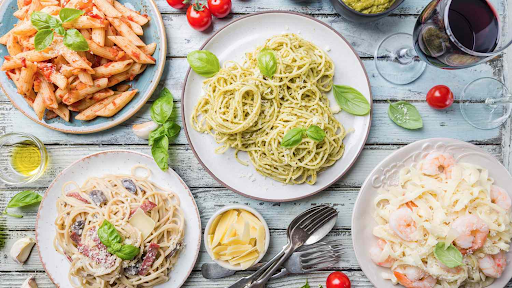From its hearty pasta dishes to wines perfectly paired for the palate, Italian cuisine offers some of the most universally enjoyed foods across the globe. But what gives this epicurean tradition its unwavering mass appeal over the ages?
Simplicity Allows Natural Flavors To Shine
Italian cooking cherishes high-quality, seasonal ingredients by preparing them simply to let their fresh, bright flavors come through. Unlike other cuisines, Italian food doesn’t rely heavily on complex spices or sauces that mask underlying tastes. The ingredients speak for themselves.
This simplicity allows you to taste the ripe tomatoes, sweet basil, creamy mozzarella, or bright lemon. Each component offers a clear flavor that melds harmoniously with the rest, making eating Italian food a vibrant, sensory experience.
Regional Diversity Creates Dynamic Variety
Italian cuisine is highly regional, with each area offering its own signature ingredients, dishes, and styles, creating an amazing diversity of flavors across the country. From seafood risotto in Venice to eggplant Parmesan in Sicily to truffles in Piedmont, this kaleidoscope of local traditions keeps Italian food exciting.
This rich regionality means you could eat your way through Italy and never have the same meal twice. The seemingly endless intersections of place-based foods, prep techniques, and wine pairings make the cuisine ever-engaging.
Mastering the Classics…Simply Exceptional
While the ingredients and preparations look deceptively simple, Italians have honed pasta, pizza, risotto, and other classics through generations to achieve sublime flavors and textures. The concepts feel familiar, but proper technique and quality ingredients elevate these staples to new heights.
In Italian hands, classics become far more than the sum of their parts. A hand-kneaded pizza crust, al dente pasta, or creamy cacio e pepe transcend their humble origins thanks to their mastery.
Obsession With Quality Creates Intensity of Flavor
Italians are fastidious about using produce, cheese, seafood, and other ingredients at their peak freshness and ultimate ripeness. This produces intense, concentrated flavors that can’t be replicated with subpar components. From the sweetest summer tomatoes and just-caught shrimp to milky-fresh mozzarella, quality reigns supreme.
This emphasis on freshness is why something as simple as a Caprese salad can feel so sublime. At a molecular level, those perfect ingredients vibrate with flavor in each bite.
Wine Culture Adds Another Dimension
Centuries of winemaking offers Italy an astonishing range of food-friendly wines to complement its cuisine. From bright whites to food-friendly reds, Italian wines feel inherently designed for the table thanks to this storied history.
The Italians wrote the book on pairing wine with food. Mineral-laced Vermentino dances with seafood; Barolo’s tannins wrap around meat sauces. The possibilities are as dynamic as the country’s regional wines and dishes.
Convivial Dining Culture Brings Joy
In Italian culture, food is meant for gathering around the table rather than eating on the go. Lingering over leisurely meals with friends and family is integral for connection, storytelling, and savoring regional specialties.
There’s a reason restaurants feel more vibrant in Italy. Dining isn’t just about sustenance; it is joyful sustenance shared with others. This convivial atmosphere makes their cuisine even more special.
Passion for Tradition Equals Timeless Dishes
Italians are rightfully proud of their cuisine and work tirelessly to preserve cooking traditions passed down through generations. Recipes aren’t changed on a whim; they are preserved out of respect.
This passion for tradition is why you can still find obscure pasta shapes and regional wine grapes that have survived against the odds. Every regional Italian dish relays a unique story of local culture, identity, and community through recipes preserved over time.
Layering Creates Complexity of Flavor
The recipes for soffritto and strata build layer upon layer of flavor. Soffritto involves sautéing aromatics like onions or celery, while strata involves topping dishes with ingredients like ragùs and cheese.
This interplay creates nuanced flavors that unfold with each bite. Much like a grand opera, Italian food hits notes from start to finish: first, the bright overture, then more bass notes, and finally, an intense crescendo.
Italian cuisine is comfortingly familiar, thrillingly varied, and simultaneously simple yet complex. This magical fusion of art and joy keeps it in vogue.
Visit an Italian Restaurant for a Cultural and Gastronomic Experience
If you adore incredible food and wine, bask in the Italian culinary traditions passed down through the ages. Let generations of refinement be your guide to la dolce vita.

Melody Roth, a seasoned blog writer with a passion for the delectable world of food, specializes in crafting mouth-watering articles on favorites like pizza and burgers. With years of experience under her belt, Melody serves up stories as tantalizing as the dishes she describes, making her an invaluable voice in the culinary blogging realm.

